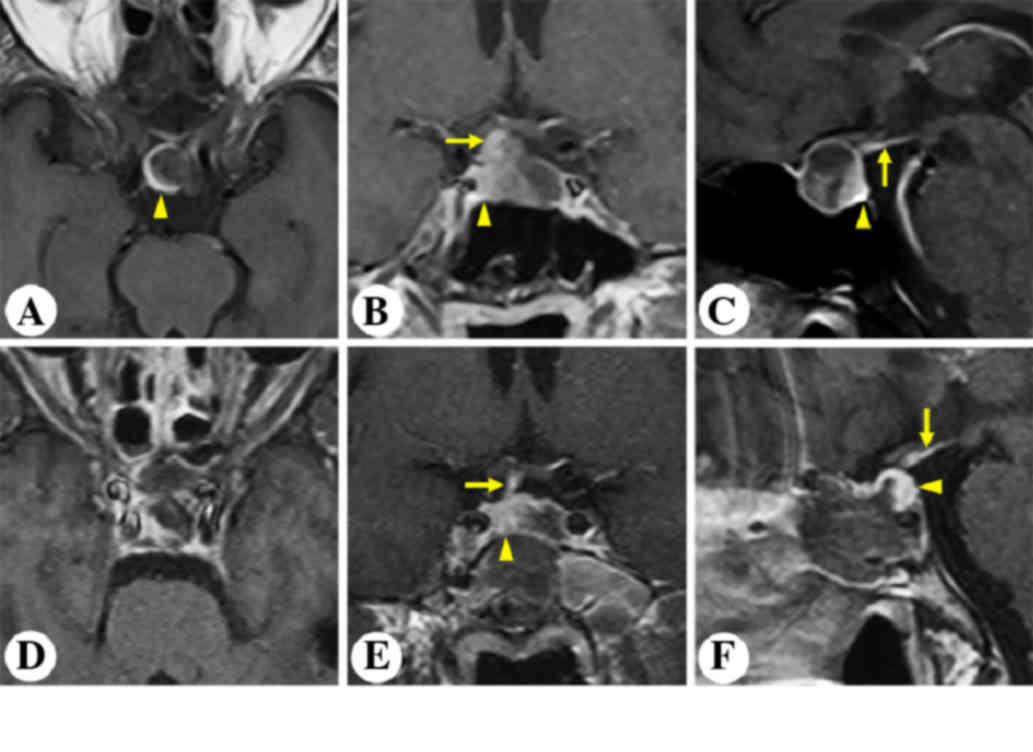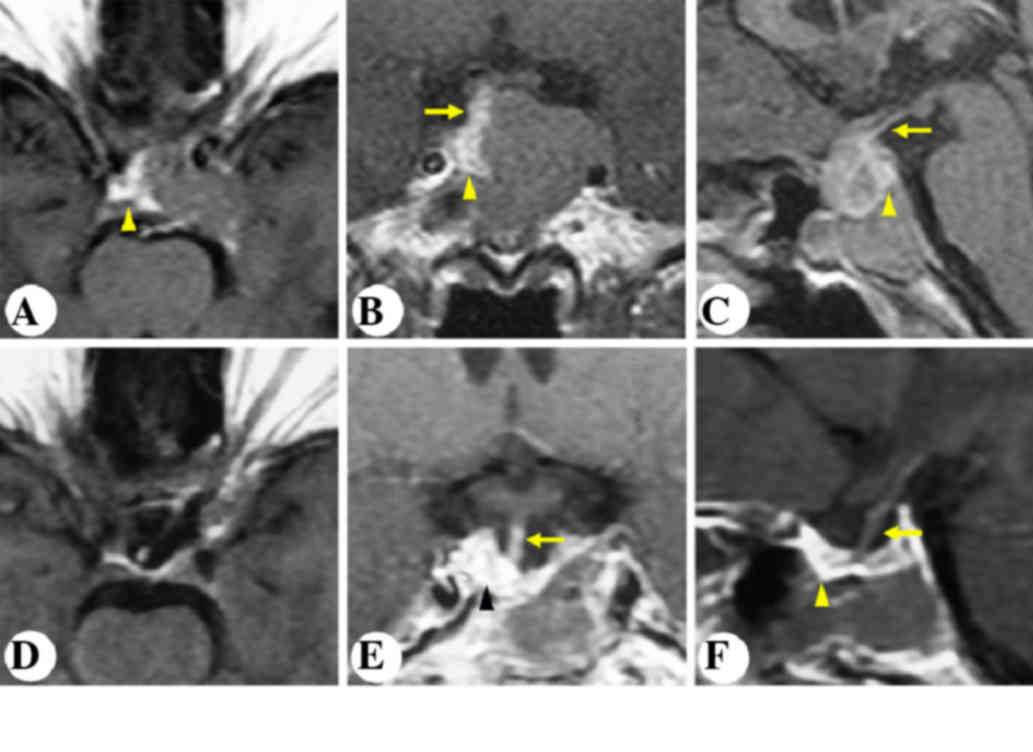|
1
|
Caton R: Notes of a case of acromegaly
treated by operation. Br Med J. 2:1421–1423. 1893. View Article : Google Scholar : PubMed/NCBI
|
|
2
|
Horsley V: On the technique of operations
on the central nervous system. Br Med J. 2:411–423. 1906.
View Article : Google Scholar
|
|
3
|
Schloffer H: Successful surgical treatment
of a pituitary tumor in the nasal cavity. Wien Klin Wochenschr.
20:621–624. 1907.(In German).
|
|
4
|
Hardy J: Surgery of the pituitary gland,
using the trans-sphenoidal approach. Comparative study of 2
technical methods. Union Med Can. 96:702–712. 1967.(In French).
PubMed/NCBI
|
|
5
|
Buchfelder M and Kreutzer J: Transcranial
surgery for pituitary adenomas. Pituitary. 11:375–384. 2008.
View Article : Google Scholar : PubMed/NCBI
|
|
6
|
Wilson CB: A decade of pituitary
microsurgery. The Herbert Olivecrona lecture. J Neurosurg.
61:814–833. 1984. View Article : Google Scholar : PubMed/NCBI
|
|
7
|
Laws ER and Jane JA Jr: Pituitary
tumors-long-term outcomes and expectations. Clin Neurosurg.
48:306–319. 2001.PubMed/NCBI
|
|
8
|
Wilson CB: Surgical management of
pituitary tumors. J Clin Endocrinol Metab. 82:2381–2385. 1997.
View Article : Google Scholar : PubMed/NCBI
|
|
9
|
Mortini P: Cons: Endoscopic endonasal
transsphenoidal pituitary surgery is not superior to microscopic
transsphenoidal surgery for pituitary adenomas. Endocrine.
47:415–420. 2014. View Article : Google Scholar : PubMed/NCBI
|
|
10
|
Apuzzo ML, Heifetz MD, Weiss MH and Kurze
T: Neurosurgical endoscopy using the side-viewing telescope. J
Neurosurg. 46:398–400. 1977. View Article : Google Scholar : PubMed/NCBI
|
|
11
|
Jho HD, Carrau RL, Ko Y and Daly MA:
Endoscopic pituitary surgery: An early experience. Surg Neurol.
47:213–222; discussion 222–223. 1997. View Article : Google Scholar : PubMed/NCBI
|
|
12
|
Alfieri A: Endoscopic endonasal
transsphenoidal approach to the sellar region: Technical evolution
of the methodology and refinement of a dedicated instrumentation. J
Neurosurg Sci. 43:85–92. 1999.PubMed/NCBI
|
|
13
|
Mamelak AN: Pro: Endoscopic endonasal
transsphenoidal pituitary surgery is superior to microscope-based
transsphenoidal surgery. Endocrine. 47:409–414. 2014. View Article : Google Scholar : PubMed/NCBI
|
|
14
|
Dehdashti AR, Ganna A, Karabatsou K and
Gentili F: Pure endoscopic endonasal approach for pituitary
adenomas: Early surgical results in 200 patients and comparison
with previous microsurgical series. Neurosurgery. 62:1006–1015;
discussion 1015–1017. 2008. View Article : Google Scholar : PubMed/NCBI
|
|
15
|
Ammirati M, Wei L and Ciric I: Short-term
outcome of endoscopic versus microscopic pituitary adenoma surgery:
A systematic review and meta-analysis. J Neurol Neurosurg
Psychiatry. 84:843–849. 2013. View Article : Google Scholar : PubMed/NCBI
|
|
16
|
Shou XF, Li SQ, Wang YF, Zhao Y, Jia PF
and Zhou LF: Treatment of pituitary adenomas with a transsphenoidal
approach. Neurosurgery. 56:249–256; discussion 249–256. 2005.
View Article : Google Scholar : PubMed/NCBI
|
|
17
|
Kovacs K and Horvath E: Pathology of
pituitary tumors. Endocrinol Metab Clin North Am. 16:529–551.
1987.PubMed/NCBI
|
|
18
|
Scheithauer BW: Surgical pathology of the
pituitary: The adenomas. Part I. Pathol Annu. 19:317–374.
1984.PubMed/NCBI
|
|
19
|
Laws ER and Jane JA Jr: Neurosurgical
approach to treating pituitary adenomas. Growth Horm IGF Res.
15:(Suppl A). S36–S41. 2005. View Article : Google Scholar : PubMed/NCBI
|
|
20
|
Wilson CB: Endocrine-inactive pituitary
adenomas. Clin Neurosurg. 38:10–31. 1991.
|
|
21
|
Fatemi N, Dusick JR, Mattozo C, McArthur
DL, Cohan P, Boscardin J, Wang C, Swerdloff RS and Kelly DF:
Pituitary hormonal loss and recovery after transsphenoidal adenoma
removal. Neurosurgery. 63:709–718; discussion 718–719. 2008.
View Article : Google Scholar : PubMed/NCBI
|
|
22
|
Kirsten Forbes JK and White WL: Imaging of
the pituitary gland. Barrow Quarterly. 18:9–19. 2002.
|
|
23
|
Cottier JP, Destrieux C, Brunereau L,
Bertrand P, Moreau L, Jan M and Herbreteau D: Cavernous sinus
invasion by pituitary adenoma: MR imaging. Radiology. 215:463–469.
2000. View Article : Google Scholar : PubMed/NCBI
|
|
24
|
Kaufman B, Kaufman BA, Arafah BM,
Roessmann U and Selman WR: Large pituitary gland adenomas evaluated
with magnetic resonance imaging. Neurosurgery. 21:540–546. 1987.
View Article : Google Scholar : PubMed/NCBI
|
|
25
|
Rajaraman V and Schulder M: Postoperative
MRI appearance after transsphenoidal pituitary tumor resection.
Surg Neurol. 52:592–598; discussion 598–599. 1999. View Article : Google Scholar : PubMed/NCBI
|
|
26
|
Oldfield EH: Pituitary adenoma
identification. J Neurosurg. 116:933–934; author reply 934. 2012.
View Article : Google Scholar : PubMed/NCBI
|
|
27
|
Simmons GE, Suchnicki JE, Rak KM and
Damiano TR: MR imaging of the pituitary stalk: Size, shape, and
enhancement pattern. AJR Am J Roentgenol. 159:375–377. 1992.
View Article : Google Scholar : PubMed/NCBI
|
|
28
|
Cho CH, Barkhoudarian G, Hsu L, Bi WL,
Zamani AA and Laws ER: Magnetic resonance imaging validation of
pituitary gland compression and distortion by typical sellar
pathology. J Neurosurg. 119:1461–1466. 2013. View Article : Google Scholar : PubMed/NCBI
|
|
29
|
de Divitiis E and de Divitiis O: Surgery
for large pituitary adenomas: What is the best way? World
Neurosurg. 77:448–450. 2012. View Article : Google Scholar : PubMed/NCBI
|
|
30
|
Youssef AS, Agazzi S and van Loveren HR:
Transcranial surgery for pituitary adenomas. Neurosurgery.
57:(Suppl 1). S168–S175; discussion 168–175. 2005.
|
|
31
|
Berker M, Hazer DB, Yücel T, Gürlek A,
Cila A, Aldur M and Onerci M: Complications of endoscopic surgery
of the pituitary adenomas: Analysis of 570 patients and review of
the literature. Pituitary. 15:288–300. 2012. View Article : Google Scholar : PubMed/NCBI
|















